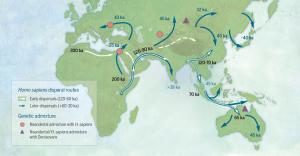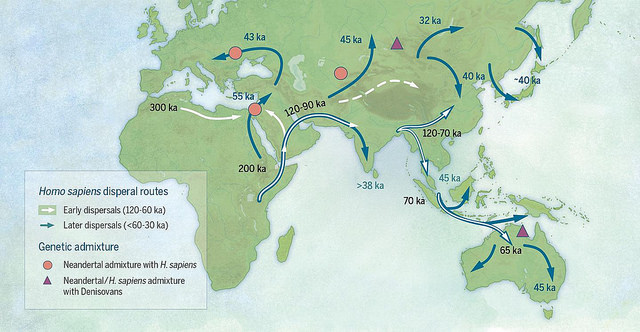
A review of recent research on dispersals by early modern humans from Africa to Asia by researchers from the Max Planck Institute for the Science of Human History and the University of Hawai’i at Manoa confirms that the traditional view of a single dispersal of anatomically modern humans out of Africa around 60,000 years ago can no longer be seen as the full story. The analysis, published in the journal Science, reviews the plethora of new discoveries being reported from Asia over the past decade, which were made possible by technological advances and interdisciplinary collaborations, and shows that Homo sapiens reached distant parts of the Asian continent, as well as Near Oceania, much earlier than previously thought. Additionally, evidence that modern humans interbred with other hominins already present in Asia, such as Neanderthals and Denisovans, complicates the evolutionary history of our species.
New model: Multiple dispersals of modern humans out of Africa, beginning as early as 120,000 years ago
The authors brought together findings from multiple recent studies to refine the picture of human dispersals out of Africa and into Asia. While scientists once thought that humans first left Africa in a single wave of migration about 60,000 years ago, recent studies have identified modern human fossils in far reaches of Asia that are potentially much older. For example, H. sapiens remains have been found at multiple sites in southern and central China that have been dated to between 70,000 and 120,000 years ago. Additional finds indicate that modern humans reached Southeast Asia and Australia prior to 60,000 years ago.
However, other recent studies do confirm that all present-day non-African populations branched off from a single ancestral population in Africa approximately 60,000 years ago. This could indicate that there were multiple, smaller dispersals of humans out of Africa beginning as early as 120,000 years ago, followed by a major dispersal 60,000 years ago. While the recent dispersal contributed the bulk of the genetic make-up of present-day non-Africans, the earlier dispersals are still evident.
“The initial dispersals out of Africa prior to 60,000 years ago were likely by small groups of foragers, and at least some of these early dispersals left low-level genetic traces in modern human populations. A later, major ‘Out of Africa’ event most likely occurred around 60,000 years ago or thereafter,” explains Michael Petraglia of the Max Planck Institute for the Science of Human History.
Multiple interbreeding events
Recent genetic research has resolved the question of whether or not modern humans interbred with other ancient hominins – they definitely did. Modern humans interbred not only with Neanderthals, but also with our recently-discovered relatives the Denisovans, as well as a currently unidentified population of pre-modern hominins. One estimate is that all present-day non-Africans have 1-4% Neanderthal heritage, while another group has estimated that modern Melanesians have an average of 5% Denisovan heritage. In all, it is now clear that modern humans, Neanderthals, Denisovans and perhaps other hominin groups likely overlapped in time and space in Asia, and they certainly had many instances of interaction.
The increasing evidence of interactions suggests that the spread of material culture is also more complicated than previously thought. “Indeed, what we are seeing in the behavioral record is that the spread of so-called modern human behaviors did not occur in a simple time-transgressive process from west to east. Rather, ecological variation needs to be considered in concert with behavioral variation between the different hominin populations present in Asia during the Late Pleistocene,” explains Christopher Bae of the University of Hawai’i at Manoa.
In light of these new discoveries, our understanding of human movements across the Old World has become much more complex, and there are still many questions left open. The authors argue for the development of more complicated models of human dispersals and for conducting new research in the many areas of Asia where none has been done to date. Additionally, it will be important to review materials collected prior to the development of modern analytic methods, to see what more can now be learned from them. “Fortunately,” states Katerina Douka, also of the Max Planck Institute for the Science of Human History, “there have been an increasing number of multidisciplinary research programs launched in Asia over the past few decades. The information that is being reported is helping to fill in the gaps in the evolutionary records.”
“It is an exciting time to be involved with interdisciplinary research projects across Asia,” adds Bae.
_____________________________________
Map of sites and postulated migratory pathways associated with modern humans dispersing across Asia during the Late Pleistocene. Credit: Bae et al. 2017. On the origin of modern humans: Asian perspectives. Science. Image by: Katerina Douka and Michelle O’Reilly
Article Source: MAX PLANCK INSTITUTE FOR THE SCIENCE OF HUMAN HISTORY news release.
If you liked this story, you may like this one: The First Arabians
_________________________________________________
Receive 30 days free access to the popular new CuriosityStream lineup of documentaries on science, history, nature, and technology as a new Popular Archaeology premium subscriber.
___________________________________________
Travel and learn with Far Horizons.
______







